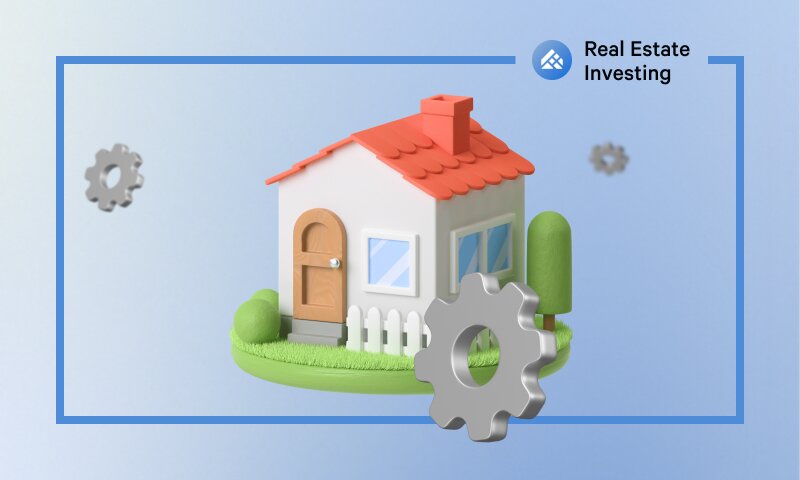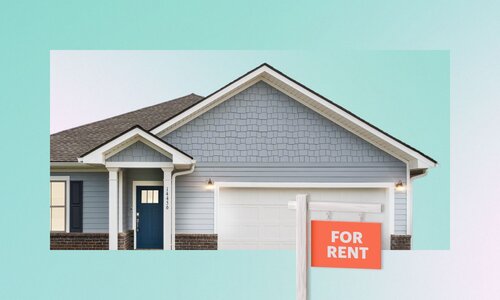Owning rental properties can be lucrative, but your success can hinge on effective management. A well-managed property maintains value, attracts quality tenants, and leads to consistent income and cash flow. Moreover, effective management ensures compliance with legal regulations, thus minimizing the risk of disputes. And it leads to a positive experience for both you and your tenants.
Here’s everything you need to know about managing a rental property.
What Does Property Management Involve?
Rental property management aims to maintain and enhance the value of real estate. From tenant relations to financial oversight and property maintenance, here’s some of what you’ll be responsible for:
- Property preparation: Getting the investment property ready for rent, including repairs, upgrades, and compliance with safety standards and local regulations.
- Tenant selection and onboarding: Thoroughly screening tenants, executing lease agreements, and ensuring a smooth onboarding process for new tenants.
- Maintenance and upkeep: Regular maintenance, prompt repairs, and timely addressing tenant requests.
- Financial management: Tracking rental income, managing expenses, handling taxes, and maintaining accurate financial records.
- Tenant relationship management: Handling tenant issues, addressing disputes, and ensuring healthy tenant-landlord relationships.
- Long-term strategies: Implementing growth strategies and planning for long-term success in the rental market.
Let’s talk about each aspect of how to manage a rental property.
1. Property Assessment and Repairs
Before listing a property for rent, conducting a thorough property assessment is essential. This assessment involves identifying any necessary repairs, maintenance tasks, or upgrades to make the property rental-ready. Areas to consider during this assessment include:
- Structural integrity: Check for structural issues, such as leaks, cracks, or foundational problems.
- Appliances and fixtures: Ensure that all appliances (such as HVAC systems, water heaters, etc.) and fixtures are in proper working condition.
- Safety measures: Install or check safety equipment such as smoke detectors, carbon monoxide alarms, and fire extinguishers.
- Cosmetic upgrades: Evaluate whether cosmetic improvements, such as fresh paint, new flooring, or landscaping, could enhance the property’s appeal.
Following the assessment, you’ll want to prioritize repairs and upgrades based on urgency and impact to make the property move-in ready.
2. Setting Competitive Rental Rates
Determining the right rent price is crucial for attracting renters and ensuring a steady income. To set competitive rental rates:
- Market research: Analyze the local real estate market and research similar properties in the area to understand rental trends in the neighborhood.
- Consider property features: Assess your property’s unique features, amenities, size, and condition to determine a fair market rate.
- Factor in expenses: When setting the monthly rent, account for mortgage payments, property taxes, insurance, maintenance costs, and desired profit margin.
3. Marketing the Property
Effective marketing strategies are often needed to attract potential tenants. These include:
- Online listings: Advertise the property using online platforms such as real estate websites such as Zillow, rental listing sites, and social media.
- High-quality photos and descriptions: Capture appealing photos and craft engaging property descriptions highlighting key features and amenities.
- Target audience: Tailor marketing efforts to target demographics that align with the property’s appeal, whether it’s families, professionals, or students.
4. Creating a Comprehensive Lease Agreement
A thorough and legally sound lease agreement is a pivotal step in the tenant onboarding process. You need to think about:
- Clarity and specificity: Ensure the lease agreement is clear and concise and covers all essential aspects of the rental arrangement, including rent amount, lease duration, security deposit, utilities, pet policies, and maintenance responsibilities.
- Legal compliance: Verify that the lease agreement complies with local landlord-tenant laws and regulations. If needed, seek legal counsel to draft or review the lease document.
- Customization: Tailor the lease agreement to address specific property rules and conditions, ensuring prospective tenants understand their obligations and rights.
5. Tenant Screening and Background Checks
Thorough tenant screening is crucial. To ensure a smooth ride:
- Application review: Scrutinize rental applications, verify provided information, and conduct background checks for credit history, employment, income verification, and rental references.
- Background checks: Conduct background and credit checks to assess the applicant’s criminal history, eviction records, and previous rental behaviors to gauge their reliability as tenants.
- Meet applicants: Schedule face-to-face meetings or interviews to better understand potential tenants, discuss lease terms and address any concerns or queries.
6. Setting up Rent Collection Systems
Establishing a transparent and organized system for tenant onboarding, lease agreements, and rent collection fosters a positive landlord-tenant relationship. It ensures compliance with legal requirements and financial stability when managing rental properties. For efficient rent collection processes that streamline rental income management, consider the following:
- Digital payment systems: Implement various convenient payment methods, such as online rent payment systems, direct deposits, or mobile apps.
- Clear payment policies: Clearly outline rent payment due dates, accepted payment methods, and late fee policies within the lease agreement to avoid misunderstandings.
- Automated reminders: Send timely reminders to tenants about upcoming rent due dates to ensure on-time payments and minimize delays.
7. Maintaining the Rental Property
Maintaining a rental property involves proactive and regular upkeep, prompt attention to tenant requests, and fostering efficient communication channels. Ensure:
- Scheduled inspections: Conduct routine property inspections to identify and address maintenance issues promptly. Regular inspections help detect problems early, preventing them from escalating into costly repairs.
- Preventative maintenance: Implement a preventative maintenance schedule for essential systems like HVAC, plumbing, electrical, and structural components to ensure they function optimally.
- Landscaping and exterior maintenance: Regularly landscape, paint the exterior, and maintain common areas or shared spaces to keep the property’s curb appeal.
8. Handling Tenant Requests and Repairs
Promptly addressing tenant requests and maintenance issues fosters tenant satisfaction and property well-being and reduces tenant turnover and vacancy rates. Things to keep in mind:
- Effective communication: Establish clear communication channels for tenants to report maintenance concerns, emphasizing promptness in addressing their requests.
- Prioritizing repairs: Assess and categorize repair requests based on urgency, promptly addressing critical issues that affect safety or habitability.
- Contracting reliable services: Maintain a network of reliable contractors or maintenance personnel to efficiently handle repair and maintenance tasks.
9. Efficient Communication
It seems like an afterthought, but effective communication is essential in managing rental properties smoothly. You’ll need to ensure the following:
- Clear communication protocols: Establish clear communication guidelines specifying preferred methods (email, phone, or an online portal) for tenants to contact you.
- Timely responses: Respond promptly to tenant inquiries, concerns, or maintenance requests, ensuring tenants feel valued and their issues are addressed promptly.
- Regular updates: Provide periodic updates to tenants regarding property-related matters, such as scheduled maintenance, community events, or any changes in property policies.
10. Managing Rental Income and Expenses
Managing the financial aspects of a rental property involves diligent bookkeeping, understanding tax implications, adhering to legal compliance, and ensuring responsible handling of security deposits. Here’s what you need to do:
- Record keeping: Maintain accurate records of rental income and expenses. Use rental property accounting software or spreadsheets to track rent payments, repairs, maintenance costs, property taxes, insurance, and other fees.
- Budgeting: Develop a comprehensive budget encompassing recurring expenses, emergency funds for repairs, property improvements, and potential vacancies.
- Rent collection: Establish streamlined methods, such as online payment portals or direct deposits, to ensure timely and hassle-free payments.
11. Understanding Tax Implications and Deductions
Familiarize yourself with deductible expenses like property taxes, mortgage interest, insurance, repairs, maintenance, depreciation, and professional services fees (like property management). Additionally:
- Tax benefits: Research available tax benefits for landlords, such as deductions for capital improvements, operating expenses, and the opportunity to offset rental income through deductions.
- Consult professionals: Consider seeking advice from a tax professional or accountant specializing in real estate to optimize tax strategies and maximize deductions.
12. Handling Security Deposits and Legal Compliance
Adhering to legal regulations and managing security deposits responsibly is crucial. Familiarize yourself with local, state, and federal laws governing landlord-tenant relationships, lease agreements, fair housing laws, eviction procedures, and rent control ordinances. Further, you need to understand:
- Security deposits: Understand the legal requirements for handling security deposits, including their collection, storage in separate accounts, allowable deductions, and timelines for return after lease termination.
- Documenting transactions: Keep meticulous records of security deposit transactions, including receipts, itemized deductions, and the property's condition before and after the tenant moves out.
13. Resolving Tenant Issues and Disputes
Landlords can often mitigate conflicts and create a conducive rental environment by fostering open communication, understanding eviction procedures, and maintaining positive tenant-landlord relationships. Here’s what you need to remember:
- Open communication: Encourage open communication channels. Address tenant concerns promptly and professionally to prevent minor issues from escalating into major conflicts.
- Meditation and resolution: Employ conflict resolution strategies, such as mediation or negotiation, to amicably settle disputes. Mediation often proves beneficial before resorting to legal action.
- Documenting communications: Keep a detailed record of all communications and actions to resolve disputes. This documentation can be valuable if legal intervention becomes necessary.
- Know your rights and procedures: Familiarize yourself with local eviction laws and guidelines. Understand the legal grounds for eviction, proper notice requirements, and the legal process.
- Seek legal advice: If facing an eviction situation, seek legal advice or consult an attorney experienced in landlord-tenant law to ensure compliance with legal requirements and procedures.
14. Long-Term Strategies for Success
Strategizing for long-term success involves continuous evaluation, potential improvements, and scalability. Analyze financial metrics, tenant satisfaction, and market trends to identify areas for improvement. Here’s what else you’ll need to do to ensure the long-term success of your rental business:
- Identify property upgrades: Determine potential upgrades or renovations to enhance property value or tenant experience. Upgrades like energy-efficient fixtures, improved landscaping, or modern amenities often attract quality tenants and increase property value.
- Assessing expansion opportunities: Evaluate opportunities for property expansion or diversification. When contemplating property expansions or additional acquisitions, consider factors like market demand, location potential, and financial feasibility.
- Strategic renovations or additions: Plan additional units to capitalize on market demands. Adapting to changing trends or demands can optimize property income and value.
Should You Hire a Property Manager or Do It Yourself?
Managing a property can be a substantial commitment, and deciding whether to hire a professional property management company or take a DIY approach involves careful consideration. Here are some things to think about:
- Time commitment: Hiring a property manager eases the time-consuming tasks of day-to-day property management, such as tenant interactions, maintenance requests, rent collections, and addressing issues as they arise.
- Expertise: Professional property managers bring expertise in tenant management, legalities, maintenance coordination, and market insights. However, doing it yourself will help you learn all these aspects of rental property management, especially if you’re doing this for the first time and plan to own more than one property.
- Financial considerations: Managing the property yourself can save on management fees, but it requires time and effort. While property management services charge fees, they often streamline operations and potentially enhance property value or rental income.
- Property size and scale: Larger or multiple properties might benefit from professional management to efficiently handle the complexity and volume. Self-management might be more feasible and cost-effective for a single or smaller property portfolio.
From property assessment and repairs to tenant screening and financial management, each aspect of property management plays a crucial role in fostering a positive experience for both landlords and tenants. Whether you choose to manage your property yourself or enlist the expertise of a professional property management company, understanding the intricacies of property management is key to long-term success in the rental business.
Lesson 5: How to Read a Real Estate Profit and Loss Statement
Interested in real estate investment but not sure where to start? Explore Arrived's REIT options, designed to accommodate investors with budgets ranging from $100 to $10,000.









